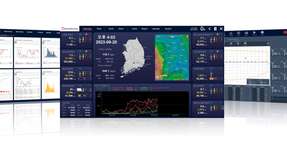What technological solutions are needed to make the All Electric Society a reality as quickly as possible?
Maren Gast:
First, we must put enormous effort into developing renewable energy sources such as photovoltaics and wind power – in Germany, in Europe, and worldwide. As these two types of power generation are highly volatile and only work when the sun is shining or the wind is blowing, we must invest in the energy storage infrastructure at the same time. Above all, more large battery storage systems are needed. In conjunction with residential storage and the bi-directional charging of electric cars, a continuous, reliable power supply based on renewable energy is possible.
What technological solutions are needed to make the All Electric Society a reality as quickly as possible?
Andreas Flandermeier:
Electrical power distribution grids are the link between renewable energy sources and the industrial, infrastructure, and mobility sectors. To distribute reliably and flexibly, the grids must be comprehensively modernized. The investment required for this should be done according to needs and based on collected grid data in order to anticipate the level of investment and optimize the plan. Further, the focus should be on grid stability. Alongside smart load management, battery energy storage systems will make a key contribution to grid stability. They enable applications such as peak load management and private consumption increase. Intelligent management systems such as those for the charging infrastructure in the mobility sector can build on them. For all this, improved data management that takes high IT standards into account is important.
What technological solutions are needed to make the All Electric Society a reality as quickly as possible?
Andreas Lautmann:
Even in the All Electric Society, the solutions in the foreseeable future will not only be 100 percent electrical. For example, in the industrial sector this applies to steel and cement production, and to shipping and aviation in the mobility sector. To make these sectors as independent of fossil fuels as power generation, the power-to-X industry must be developed alongside renewable energy. In power-to-X processes, renewable energy is converted into gaseous or liquid energy sources that can replace fossil fuels.
What technological solutions are needed to make the All Electric Society a reality as quickly as possible?
Markus Kick:
A big step towards the All Electric Society is to create transparency in the industrial sector – namely, in every single factory. After all, to achieve resource-conserving operation, diverse information is required from the entire factory infrastructure. A wide range of data must be properly collected, managed, and used. This way – and with open, interoperable control architecture – is the only way to design all types of production with maximum energy and resource efficiency.
There are so many options: What should we begin with and why?
Maren Gast:
To ensure high supply security and stable power grids, we need intelligent control technology. It must be able to intelligently manage decentralized power generation from renewable sources, as well as power feed-in, storage, and bi-directional charging. To accomplish this, standardized interfaces for simple data exchange would be highly advantageous.
There are so many options: What should we begin with and why?
Andreas Flandermeier:
One of the first efforts should be to have a more accurate map of the power grid on the distribution level, in other words in the medium-voltage and high-voltage grid. This is the only way to create a development plan in the spirit of the All Electric Society based on needs and valid data. And it is the only way to respond flexibly and promptly to dynamic changes in the grid.
There are so many options: What should we begin with and why?
Andreas Lautmann:
In the case of power-to-X, the focus should first be on extracting green hydrogen with electrolysis. After all, green hydrogen (extracted in a CO2-neutral process with renewable energy) can be used directly as an energy source. It is also the basis for many other gaseous and liquid energy sources like synthetic methane or ammoniac.
There are so many options: What should we begin with and why?
Markus Kick:
Not every factory can be completely redesigned and rebuilt overnight to make it completely compatible with the All Electric Society vision of the future. This is why it is important to first optimize existing systems in line with a minimal carbon footprint and resource-conserving production. Here, plenty can be accomplished on the data and control level – with minimally invasive measures and without interrupting or endangering production. By using the existing measuring points and currently available data intelligently for control processes, factories and their products will verifiably become more sustainable. And they will do so at the same or even higher overall equipment effectiveness.





















